Microeconomics Assignment: Market Structures, Cartels, and Competition
VerifiedAdded on 2022/09/07
|10
|2570
|16
Homework Assignment
AI Summary
This microeconomics assignment delves into various market structures, including perfect competition, monopoly, monopolistic competition, and oligopoly, examining their characteristics and implications. The assignment explores profit maximization, marginal cost, and marginal revenue within different market scenarios. It analyzes the behavior of firms in oligopolistic markets, including the dynamics of cartels and the tension between cooperation and self-interest, using OPEC as a case study. The assignment also examines the impact of market entry and exit on firms in monopolistically competitive markets, and the effects of patents on pharmaceutical companies. Furthermore, the assignment discusses revenue maximization by monopolists, comparing it to profit maximization and its effects on deadweight loss. The student demonstrates a strong understanding of economic principles through detailed analysis and examples.

Running head: MICROECONOMICS
Microeconomics
Name of the Student
Name of the University
Course ID
Microeconomics
Name of the Student
Name of the University
Course ID
Paraphrase This Document
Need a fresh take? Get an instant paraphrase of this document with our AI Paraphraser
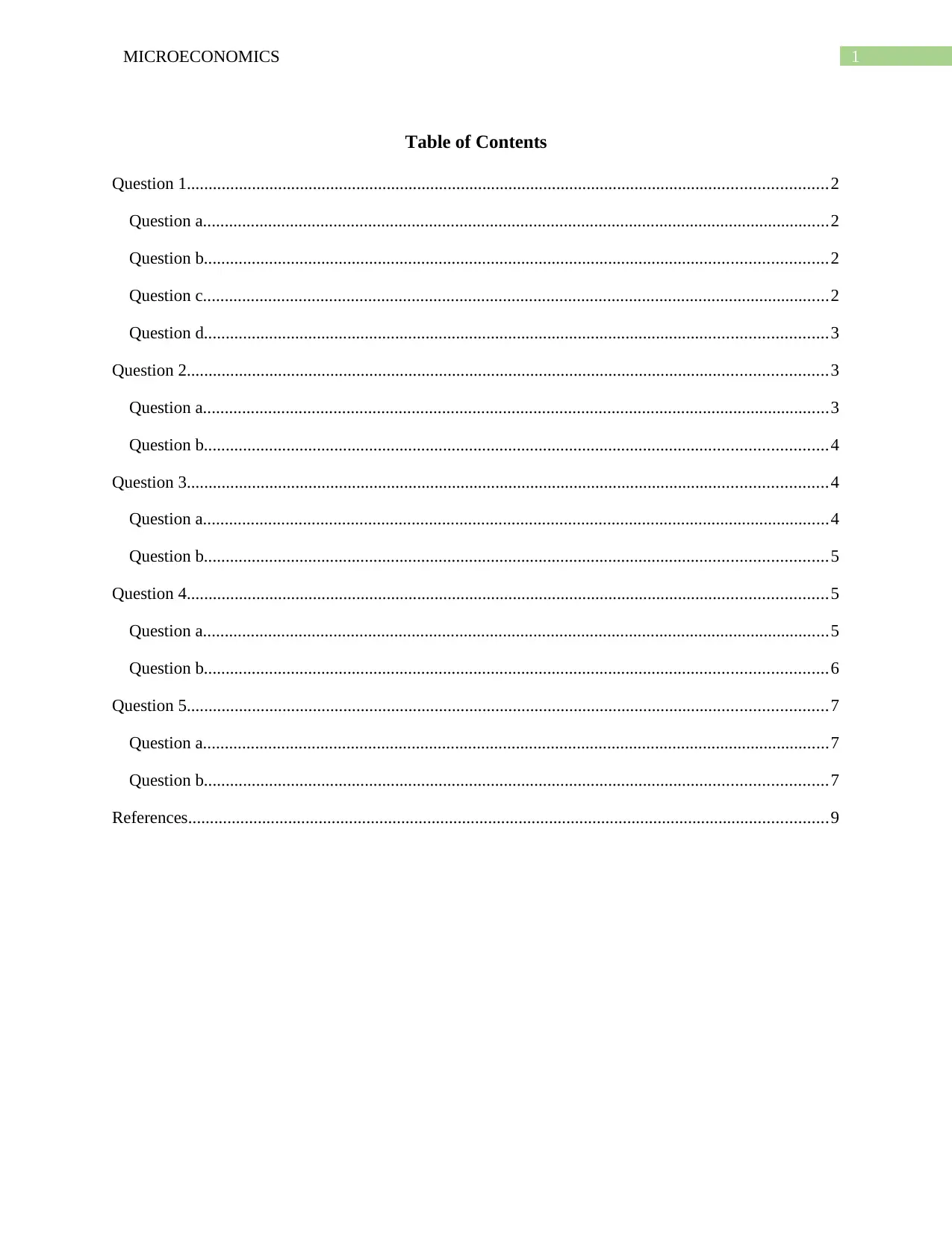
1MICROECONOMICS
Table of Contents
Question 1...................................................................................................................................................2
Question a................................................................................................................................................2
Question b...............................................................................................................................................2
Question c................................................................................................................................................2
Question d...............................................................................................................................................3
Question 2...................................................................................................................................................3
Question a................................................................................................................................................3
Question b...............................................................................................................................................4
Question 3...................................................................................................................................................4
Question a................................................................................................................................................4
Question b...............................................................................................................................................5
Question 4...................................................................................................................................................5
Question a................................................................................................................................................5
Question b...............................................................................................................................................6
Question 5...................................................................................................................................................7
Question a................................................................................................................................................7
Question b...............................................................................................................................................7
References...................................................................................................................................................9
Table of Contents
Question 1...................................................................................................................................................2
Question a................................................................................................................................................2
Question b...............................................................................................................................................2
Question c................................................................................................................................................2
Question d...............................................................................................................................................3
Question 2...................................................................................................................................................3
Question a................................................................................................................................................3
Question b...............................................................................................................................................4
Question 3...................................................................................................................................................4
Question a................................................................................................................................................4
Question b...............................................................................................................................................5
Question 4...................................................................................................................................................5
Question a................................................................................................................................................5
Question b...............................................................................................................................................6
Question 5...................................................................................................................................................7
Question a................................................................................................................................................7
Question b...............................................................................................................................................7
References...................................................................................................................................................9
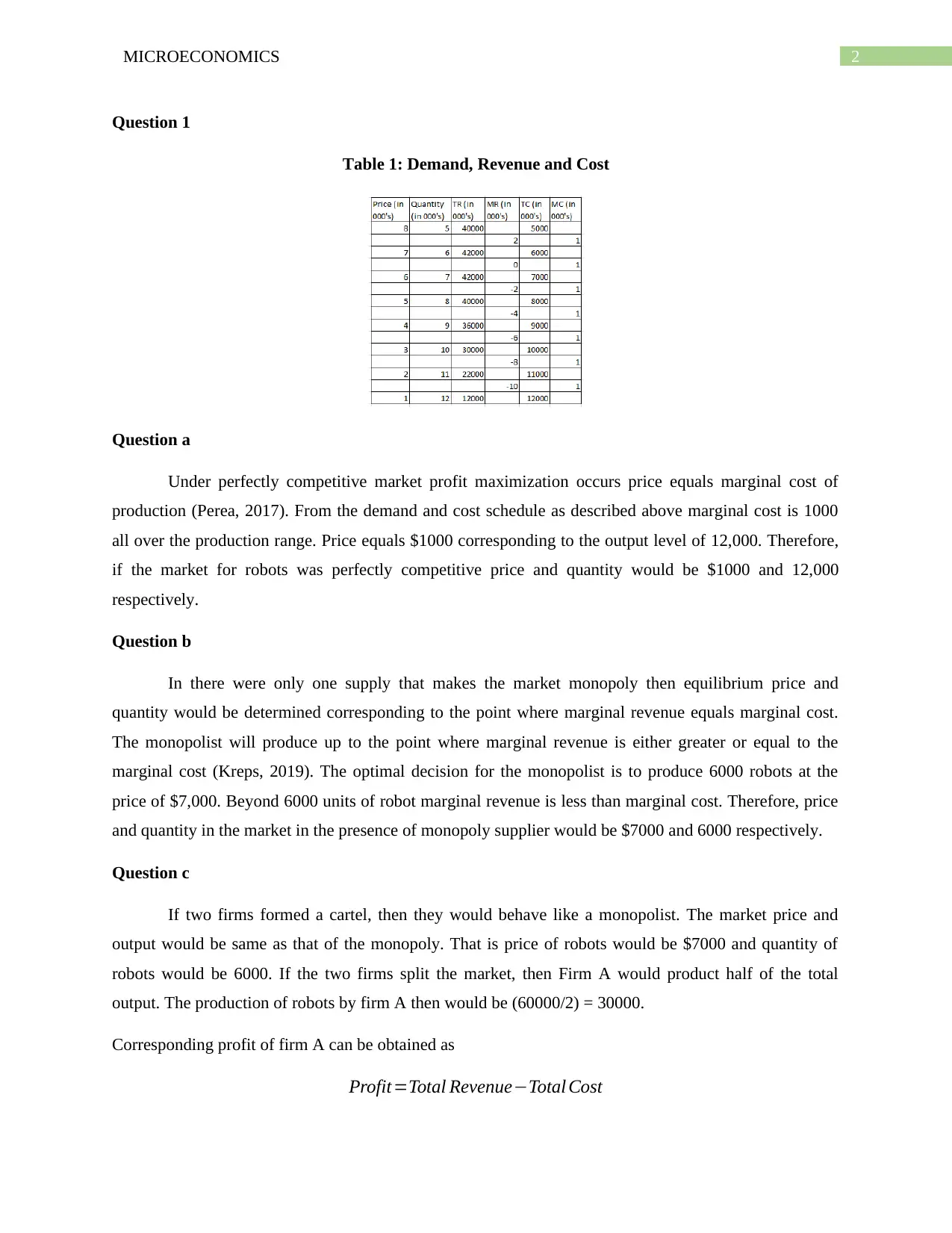
2MICROECONOMICS
Question 1
Table 1: Demand, Revenue and Cost
Question a
Under perfectly competitive market profit maximization occurs price equals marginal cost of
production (Perea, 2017). From the demand and cost schedule as described above marginal cost is 1000
all over the production range. Price equals $1000 corresponding to the output level of 12,000. Therefore,
if the market for robots was perfectly competitive price and quantity would be $1000 and 12,000
respectively.
Question b
In there were only one supply that makes the market monopoly then equilibrium price and
quantity would be determined corresponding to the point where marginal revenue equals marginal cost.
The monopolist will produce up to the point where marginal revenue is either greater or equal to the
marginal cost (Kreps, 2019). The optimal decision for the monopolist is to produce 6000 robots at the
price of $7,000. Beyond 6000 units of robot marginal revenue is less than marginal cost. Therefore, price
and quantity in the market in the presence of monopoly supplier would be $7000 and 6000 respectively.
Question c
If two firms formed a cartel, then they would behave like a monopolist. The market price and
output would be same as that of the monopoly. That is price of robots would be $7000 and quantity of
robots would be 6000. If the two firms split the market, then Firm A would product half of the total
output. The production of robots by firm A then would be (60000/2) = 30000.
Corresponding profit of firm A can be obtained as
Profit=Total Revenue−Total Cost
Question 1
Table 1: Demand, Revenue and Cost
Question a
Under perfectly competitive market profit maximization occurs price equals marginal cost of
production (Perea, 2017). From the demand and cost schedule as described above marginal cost is 1000
all over the production range. Price equals $1000 corresponding to the output level of 12,000. Therefore,
if the market for robots was perfectly competitive price and quantity would be $1000 and 12,000
respectively.
Question b
In there were only one supply that makes the market monopoly then equilibrium price and
quantity would be determined corresponding to the point where marginal revenue equals marginal cost.
The monopolist will produce up to the point where marginal revenue is either greater or equal to the
marginal cost (Kreps, 2019). The optimal decision for the monopolist is to produce 6000 robots at the
price of $7,000. Beyond 6000 units of robot marginal revenue is less than marginal cost. Therefore, price
and quantity in the market in the presence of monopoly supplier would be $7000 and 6000 respectively.
Question c
If two firms formed a cartel, then they would behave like a monopolist. The market price and
output would be same as that of the monopoly. That is price of robots would be $7000 and quantity of
robots would be 6000. If the two firms split the market, then Firm A would product half of the total
output. The production of robots by firm A then would be (60000/2) = 30000.
Corresponding profit of firm A can be obtained as
Profit=Total Revenue−Total Cost
⊘ This is a preview!⊘
Do you want full access?
Subscribe today to unlock all pages.

Trusted by 1+ million students worldwide
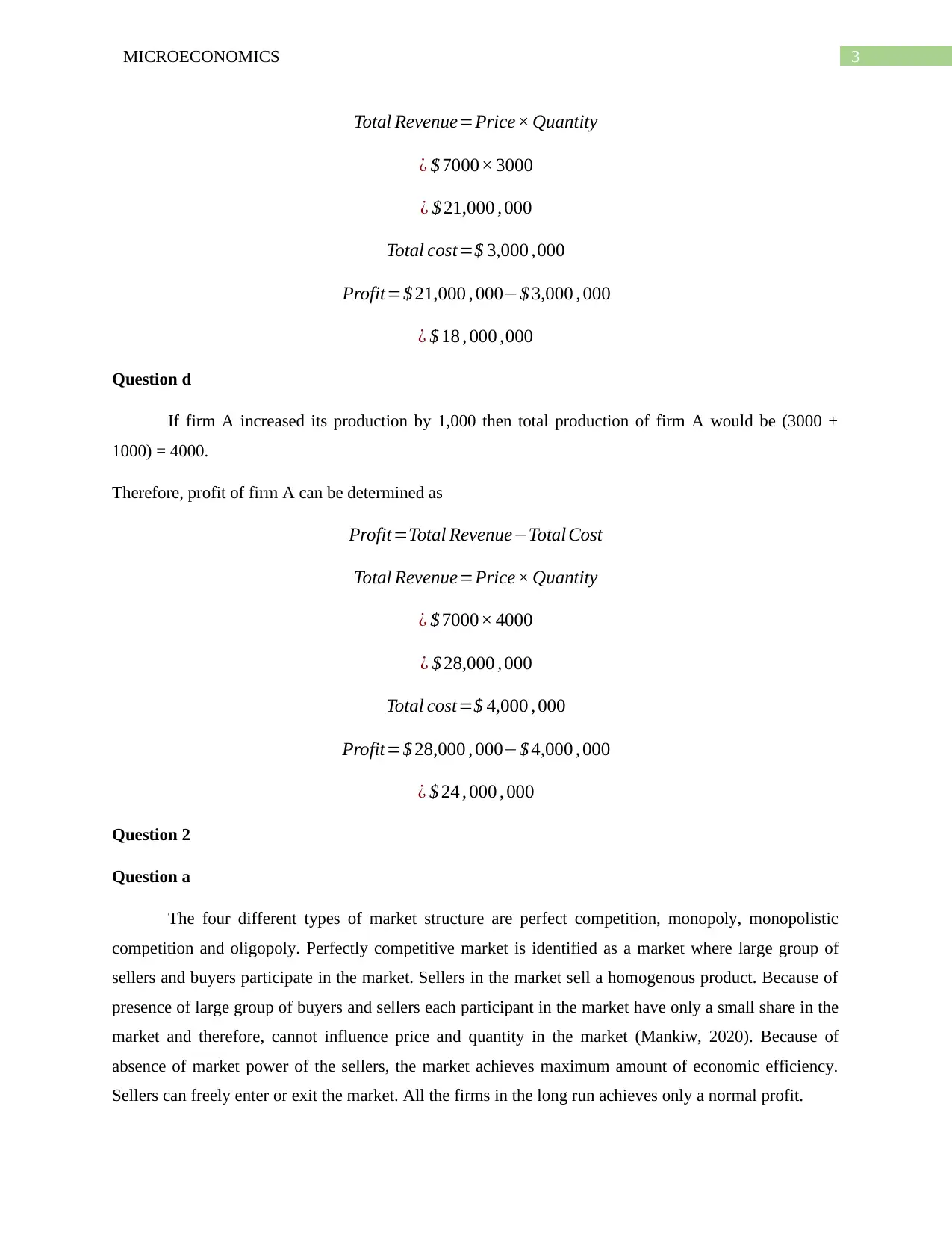
3MICROECONOMICS
Total Revenue=Price× Quantity
¿ $ 7000× 3000
¿ $ 21,000 , 000
Total cost=$ 3,000 ,000
Profit=$ 21,000 , 000−$ 3,000 , 000
¿ $ 18 , 000 ,000
Question d
If firm A increased its production by 1,000 then total production of firm A would be (3000 +
1000) = 4000.
Therefore, profit of firm A can be determined as
Profit=Total Revenue−Total Cost
Total Revenue=Price× Quantity
¿ $ 7000× 4000
¿ $ 28,000 , 000
Total cost=$ 4,000 , 000
Profit=$ 28,000 , 000−$ 4,000 , 000
¿ $ 24 , 000 , 000
Question 2
Question a
The four different types of market structure are perfect competition, monopoly, monopolistic
competition and oligopoly. Perfectly competitive market is identified as a market where large group of
sellers and buyers participate in the market. Sellers in the market sell a homogenous product. Because of
presence of large group of buyers and sellers each participant in the market have only a small share in the
market and therefore, cannot influence price and quantity in the market (Mankiw, 2020). Because of
absence of market power of the sellers, the market achieves maximum amount of economic efficiency.
Sellers can freely enter or exit the market. All the firms in the long run achieves only a normal profit.
Total Revenue=Price× Quantity
¿ $ 7000× 3000
¿ $ 21,000 , 000
Total cost=$ 3,000 ,000
Profit=$ 21,000 , 000−$ 3,000 , 000
¿ $ 18 , 000 ,000
Question d
If firm A increased its production by 1,000 then total production of firm A would be (3000 +
1000) = 4000.
Therefore, profit of firm A can be determined as
Profit=Total Revenue−Total Cost
Total Revenue=Price× Quantity
¿ $ 7000× 4000
¿ $ 28,000 , 000
Total cost=$ 4,000 , 000
Profit=$ 28,000 , 000−$ 4,000 , 000
¿ $ 24 , 000 , 000
Question 2
Question a
The four different types of market structure are perfect competition, monopoly, monopolistic
competition and oligopoly. Perfectly competitive market is identified as a market where large group of
sellers and buyers participate in the market. Sellers in the market sell a homogenous product. Because of
presence of large group of buyers and sellers each participant in the market have only a small share in the
market and therefore, cannot influence price and quantity in the market (Mankiw, 2020). Because of
absence of market power of the sellers, the market achieves maximum amount of economic efficiency.
Sellers can freely enter or exit the market. All the firms in the long run achieves only a normal profit.
Paraphrase This Document
Need a fresh take? Get an instant paraphrase of this document with our AI Paraphraser
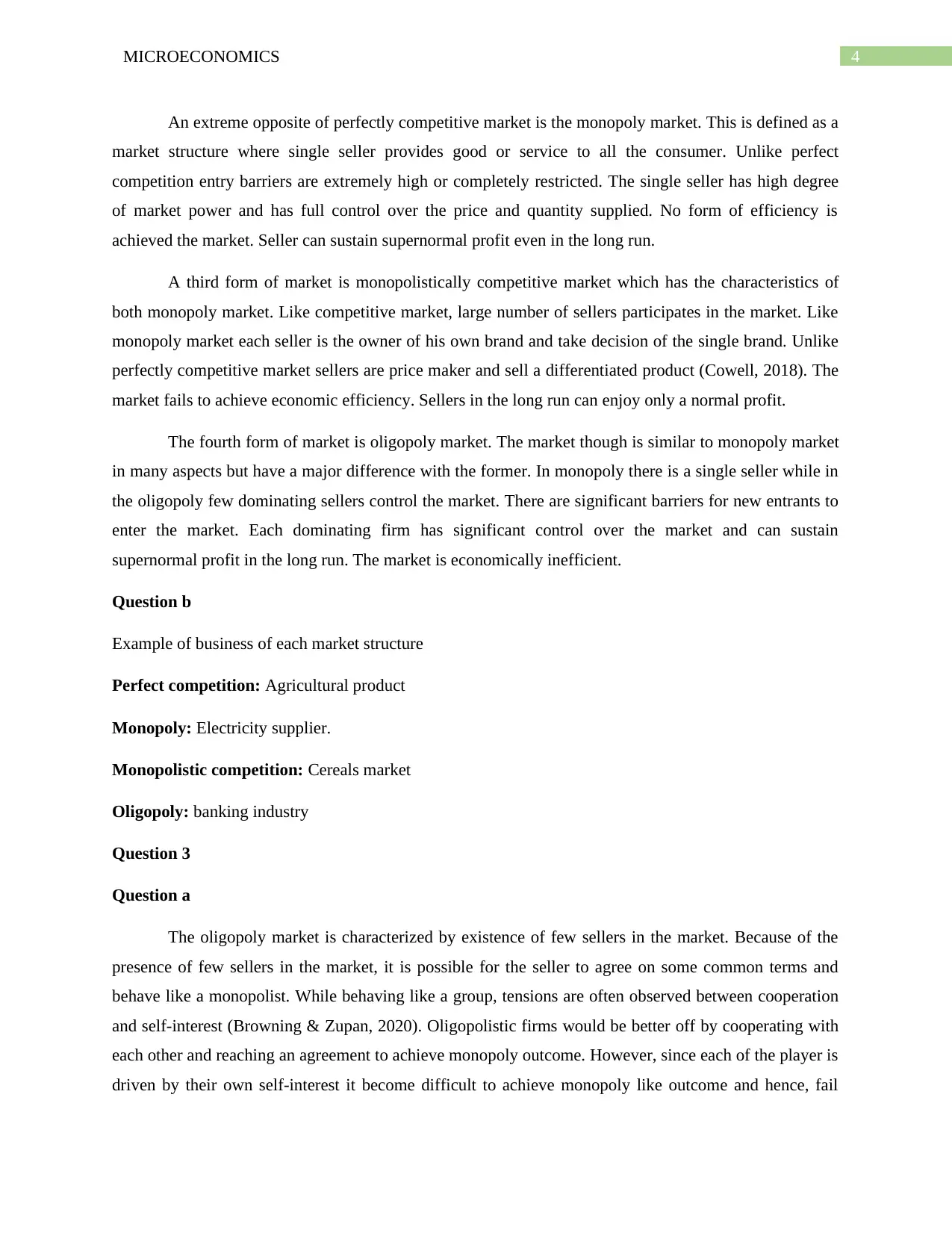
4MICROECONOMICS
An extreme opposite of perfectly competitive market is the monopoly market. This is defined as a
market structure where single seller provides good or service to all the consumer. Unlike perfect
competition entry barriers are extremely high or completely restricted. The single seller has high degree
of market power and has full control over the price and quantity supplied. No form of efficiency is
achieved the market. Seller can sustain supernormal profit even in the long run.
A third form of market is monopolistically competitive market which has the characteristics of
both monopoly market. Like competitive market, large number of sellers participates in the market. Like
monopoly market each seller is the owner of his own brand and take decision of the single brand. Unlike
perfectly competitive market sellers are price maker and sell a differentiated product (Cowell, 2018). The
market fails to achieve economic efficiency. Sellers in the long run can enjoy only a normal profit.
The fourth form of market is oligopoly market. The market though is similar to monopoly market
in many aspects but have a major difference with the former. In monopoly there is a single seller while in
the oligopoly few dominating sellers control the market. There are significant barriers for new entrants to
enter the market. Each dominating firm has significant control over the market and can sustain
supernormal profit in the long run. The market is economically inefficient.
Question b
Example of business of each market structure
Perfect competition: Agricultural product
Monopoly: Electricity supplier.
Monopolistic competition: Cereals market
Oligopoly: banking industry
Question 3
Question a
The oligopoly market is characterized by existence of few sellers in the market. Because of the
presence of few sellers in the market, it is possible for the seller to agree on some common terms and
behave like a monopolist. While behaving like a group, tensions are often observed between cooperation
and self-interest (Browning & Zupan, 2020). Oligopolistic firms would be better off by cooperating with
each other and reaching an agreement to achieve monopoly outcome. However, since each of the player is
driven by their own self-interest it become difficult to achieve monopoly like outcome and hence, fail
An extreme opposite of perfectly competitive market is the monopoly market. This is defined as a
market structure where single seller provides good or service to all the consumer. Unlike perfect
competition entry barriers are extremely high or completely restricted. The single seller has high degree
of market power and has full control over the price and quantity supplied. No form of efficiency is
achieved the market. Seller can sustain supernormal profit even in the long run.
A third form of market is monopolistically competitive market which has the characteristics of
both monopoly market. Like competitive market, large number of sellers participates in the market. Like
monopoly market each seller is the owner of his own brand and take decision of the single brand. Unlike
perfectly competitive market sellers are price maker and sell a differentiated product (Cowell, 2018). The
market fails to achieve economic efficiency. Sellers in the long run can enjoy only a normal profit.
The fourth form of market is oligopoly market. The market though is similar to monopoly market
in many aspects but have a major difference with the former. In monopoly there is a single seller while in
the oligopoly few dominating sellers control the market. There are significant barriers for new entrants to
enter the market. Each dominating firm has significant control over the market and can sustain
supernormal profit in the long run. The market is economically inefficient.
Question b
Example of business of each market structure
Perfect competition: Agricultural product
Monopoly: Electricity supplier.
Monopolistic competition: Cereals market
Oligopoly: banking industry
Question 3
Question a
The oligopoly market is characterized by existence of few sellers in the market. Because of the
presence of few sellers in the market, it is possible for the seller to agree on some common terms and
behave like a monopolist. While behaving like a group, tensions are often observed between cooperation
and self-interest (Browning & Zupan, 2020). Oligopolistic firms would be better off by cooperating with
each other and reaching an agreement to achieve monopoly outcome. However, since each of the player is
driven by their own self-interest it become difficult to achieve monopoly like outcome and hence, fail
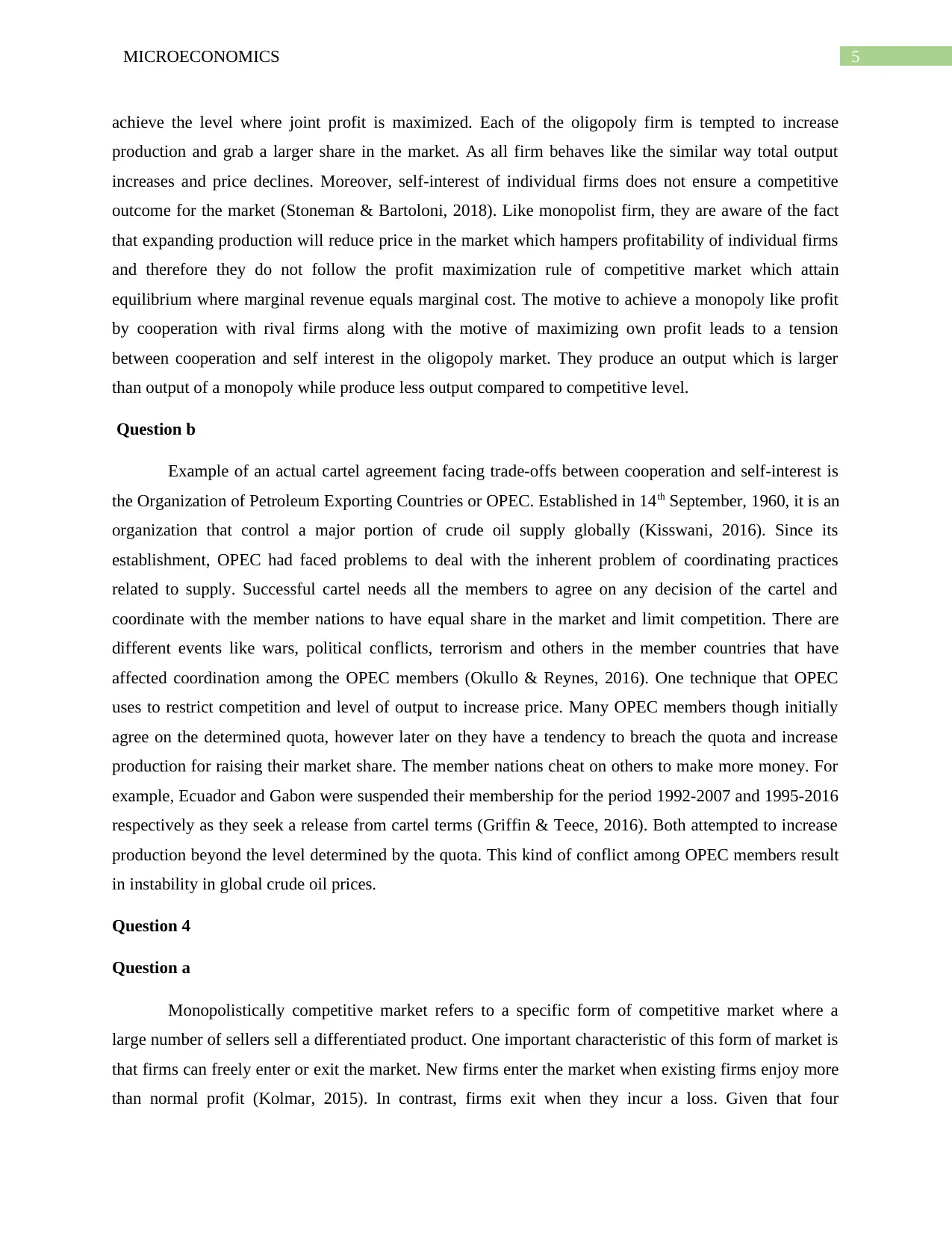
5MICROECONOMICS
achieve the level where joint profit is maximized. Each of the oligopoly firm is tempted to increase
production and grab a larger share in the market. As all firm behaves like the similar way total output
increases and price declines. Moreover, self-interest of individual firms does not ensure a competitive
outcome for the market (Stoneman & Bartoloni, 2018). Like monopolist firm, they are aware of the fact
that expanding production will reduce price in the market which hampers profitability of individual firms
and therefore they do not follow the profit maximization rule of competitive market which attain
equilibrium where marginal revenue equals marginal cost. The motive to achieve a monopoly like profit
by cooperation with rival firms along with the motive of maximizing own profit leads to a tension
between cooperation and self interest in the oligopoly market. They produce an output which is larger
than output of a monopoly while produce less output compared to competitive level.
Question b
Example of an actual cartel agreement facing trade-offs between cooperation and self-interest is
the Organization of Petroleum Exporting Countries or OPEC. Established in 14th September, 1960, it is an
organization that control a major portion of crude oil supply globally (Kisswani, 2016). Since its
establishment, OPEC had faced problems to deal with the inherent problem of coordinating practices
related to supply. Successful cartel needs all the members to agree on any decision of the cartel and
coordinate with the member nations to have equal share in the market and limit competition. There are
different events like wars, political conflicts, terrorism and others in the member countries that have
affected coordination among the OPEC members (Okullo & Reynes, 2016). One technique that OPEC
uses to restrict competition and level of output to increase price. Many OPEC members though initially
agree on the determined quota, however later on they have a tendency to breach the quota and increase
production for raising their market share. The member nations cheat on others to make more money. For
example, Ecuador and Gabon were suspended their membership for the period 1992-2007 and 1995-2016
respectively as they seek a release from cartel terms (Griffin & Teece, 2016). Both attempted to increase
production beyond the level determined by the quota. This kind of conflict among OPEC members result
in instability in global crude oil prices.
Question 4
Question a
Monopolistically competitive market refers to a specific form of competitive market where a
large number of sellers sell a differentiated product. One important characteristic of this form of market is
that firms can freely enter or exit the market. New firms enter the market when existing firms enjoy more
than normal profit (Kolmar, 2015). In contrast, firms exit when they incur a loss. Given that four
achieve the level where joint profit is maximized. Each of the oligopoly firm is tempted to increase
production and grab a larger share in the market. As all firm behaves like the similar way total output
increases and price declines. Moreover, self-interest of individual firms does not ensure a competitive
outcome for the market (Stoneman & Bartoloni, 2018). Like monopolist firm, they are aware of the fact
that expanding production will reduce price in the market which hampers profitability of individual firms
and therefore they do not follow the profit maximization rule of competitive market which attain
equilibrium where marginal revenue equals marginal cost. The motive to achieve a monopoly like profit
by cooperation with rival firms along with the motive of maximizing own profit leads to a tension
between cooperation and self interest in the oligopoly market. They produce an output which is larger
than output of a monopoly while produce less output compared to competitive level.
Question b
Example of an actual cartel agreement facing trade-offs between cooperation and self-interest is
the Organization of Petroleum Exporting Countries or OPEC. Established in 14th September, 1960, it is an
organization that control a major portion of crude oil supply globally (Kisswani, 2016). Since its
establishment, OPEC had faced problems to deal with the inherent problem of coordinating practices
related to supply. Successful cartel needs all the members to agree on any decision of the cartel and
coordinate with the member nations to have equal share in the market and limit competition. There are
different events like wars, political conflicts, terrorism and others in the member countries that have
affected coordination among the OPEC members (Okullo & Reynes, 2016). One technique that OPEC
uses to restrict competition and level of output to increase price. Many OPEC members though initially
agree on the determined quota, however later on they have a tendency to breach the quota and increase
production for raising their market share. The member nations cheat on others to make more money. For
example, Ecuador and Gabon were suspended their membership for the period 1992-2007 and 1995-2016
respectively as they seek a release from cartel terms (Griffin & Teece, 2016). Both attempted to increase
production beyond the level determined by the quota. This kind of conflict among OPEC members result
in instability in global crude oil prices.
Question 4
Question a
Monopolistically competitive market refers to a specific form of competitive market where a
large number of sellers sell a differentiated product. One important characteristic of this form of market is
that firms can freely enter or exit the market. New firms enter the market when existing firms enjoy more
than normal profit (Kolmar, 2015). In contrast, firms exit when they incur a loss. Given that four
⊘ This is a preview!⊘
Do you want full access?
Subscribe today to unlock all pages.

Trusted by 1+ million students worldwide
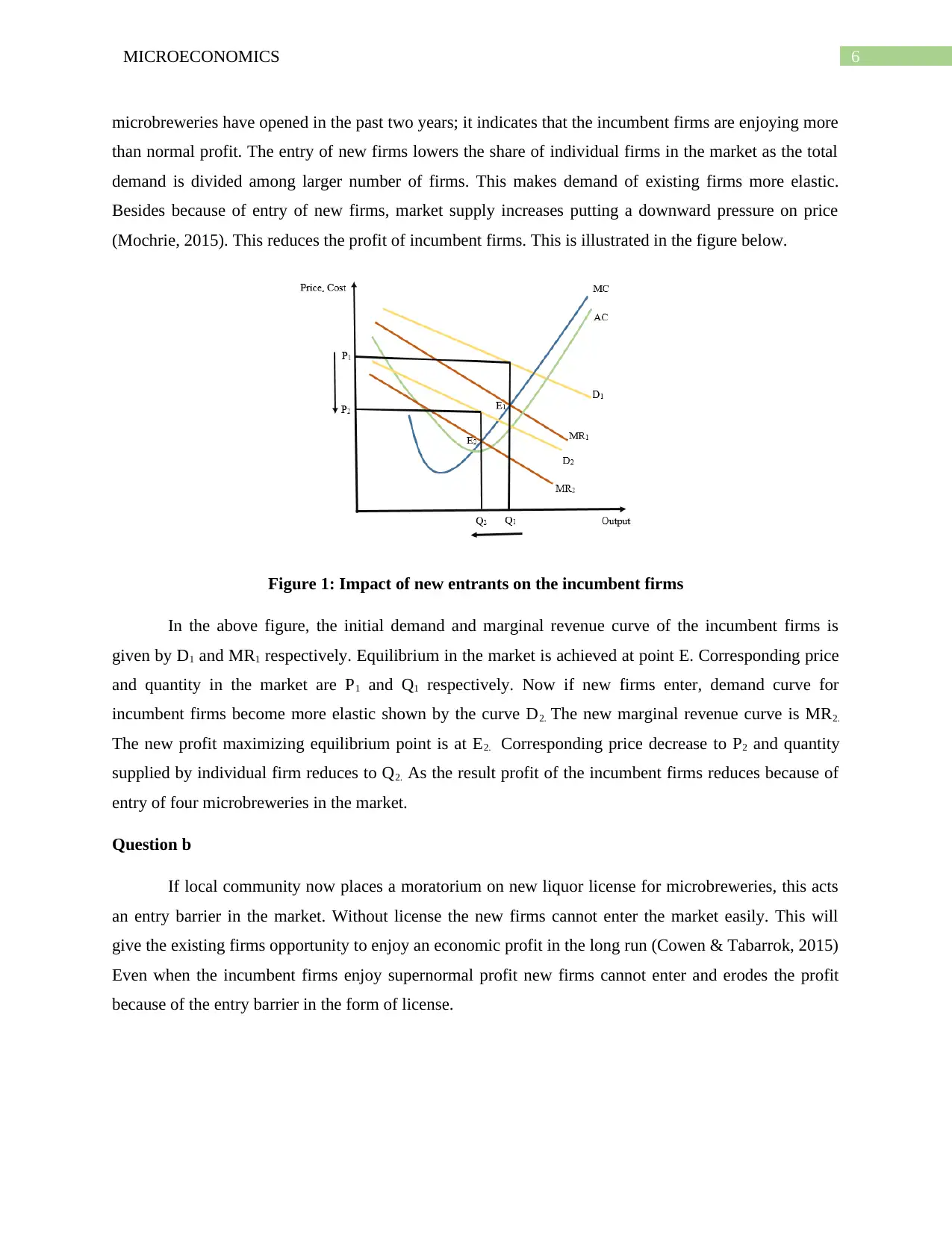
6MICROECONOMICS
microbreweries have opened in the past two years; it indicates that the incumbent firms are enjoying more
than normal profit. The entry of new firms lowers the share of individual firms in the market as the total
demand is divided among larger number of firms. This makes demand of existing firms more elastic.
Besides because of entry of new firms, market supply increases putting a downward pressure on price
(Mochrie, 2015). This reduces the profit of incumbent firms. This is illustrated in the figure below.
Figure 1: Impact of new entrants on the incumbent firms
In the above figure, the initial demand and marginal revenue curve of the incumbent firms is
given by D1 and MR1 respectively. Equilibrium in the market is achieved at point E. Corresponding price
and quantity in the market are P1 and Q1 respectively. Now if new firms enter, demand curve for
incumbent firms become more elastic shown by the curve D2. The new marginal revenue curve is MR2.
The new profit maximizing equilibrium point is at E2. Corresponding price decrease to P2 and quantity
supplied by individual firm reduces to Q2. As the result profit of the incumbent firms reduces because of
entry of four microbreweries in the market.
Question b
If local community now places a moratorium on new liquor license for microbreweries, this acts
an entry barrier in the market. Without license the new firms cannot enter the market easily. This will
give the existing firms opportunity to enjoy an economic profit in the long run (Cowen & Tabarrok, 2015)
Even when the incumbent firms enjoy supernormal profit new firms cannot enter and erodes the profit
because of the entry barrier in the form of license.
microbreweries have opened in the past two years; it indicates that the incumbent firms are enjoying more
than normal profit. The entry of new firms lowers the share of individual firms in the market as the total
demand is divided among larger number of firms. This makes demand of existing firms more elastic.
Besides because of entry of new firms, market supply increases putting a downward pressure on price
(Mochrie, 2015). This reduces the profit of incumbent firms. This is illustrated in the figure below.
Figure 1: Impact of new entrants on the incumbent firms
In the above figure, the initial demand and marginal revenue curve of the incumbent firms is
given by D1 and MR1 respectively. Equilibrium in the market is achieved at point E. Corresponding price
and quantity in the market are P1 and Q1 respectively. Now if new firms enter, demand curve for
incumbent firms become more elastic shown by the curve D2. The new marginal revenue curve is MR2.
The new profit maximizing equilibrium point is at E2. Corresponding price decrease to P2 and quantity
supplied by individual firm reduces to Q2. As the result profit of the incumbent firms reduces because of
entry of four microbreweries in the market.
Question b
If local community now places a moratorium on new liquor license for microbreweries, this acts
an entry barrier in the market. Without license the new firms cannot enter the market easily. This will
give the existing firms opportunity to enjoy an economic profit in the long run (Cowen & Tabarrok, 2015)
Even when the incumbent firms enjoy supernormal profit new firms cannot enter and erodes the profit
because of the entry barrier in the form of license.
Paraphrase This Document
Need a fresh take? Get an instant paraphrase of this document with our AI Paraphraser
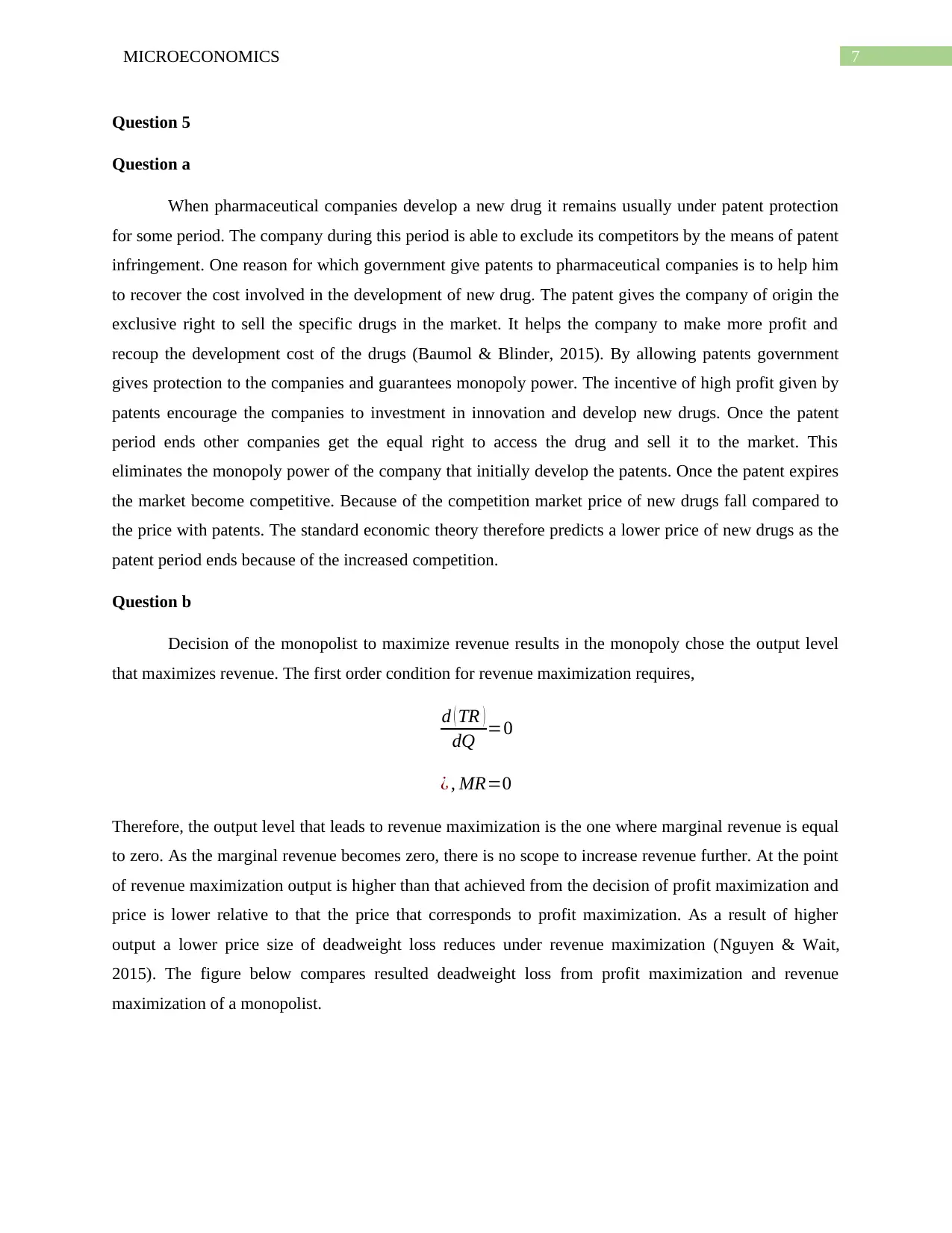
7MICROECONOMICS
Question 5
Question a
When pharmaceutical companies develop a new drug it remains usually under patent protection
for some period. The company during this period is able to exclude its competitors by the means of patent
infringement. One reason for which government give patents to pharmaceutical companies is to help him
to recover the cost involved in the development of new drug. The patent gives the company of origin the
exclusive right to sell the specific drugs in the market. It helps the company to make more profit and
recoup the development cost of the drugs (Baumol & Blinder, 2015). By allowing patents government
gives protection to the companies and guarantees monopoly power. The incentive of high profit given by
patents encourage the companies to investment in innovation and develop new drugs. Once the patent
period ends other companies get the equal right to access the drug and sell it to the market. This
eliminates the monopoly power of the company that initially develop the patents. Once the patent expires
the market become competitive. Because of the competition market price of new drugs fall compared to
the price with patents. The standard economic theory therefore predicts a lower price of new drugs as the
patent period ends because of the increased competition.
Question b
Decision of the monopolist to maximize revenue results in the monopoly chose the output level
that maximizes revenue. The first order condition for revenue maximization requires,
d ( TR )
dQ =0
¿ , MR=0
Therefore, the output level that leads to revenue maximization is the one where marginal revenue is equal
to zero. As the marginal revenue becomes zero, there is no scope to increase revenue further. At the point
of revenue maximization output is higher than that achieved from the decision of profit maximization and
price is lower relative to that the price that corresponds to profit maximization. As a result of higher
output a lower price size of deadweight loss reduces under revenue maximization (Nguyen & Wait,
2015). The figure below compares resulted deadweight loss from profit maximization and revenue
maximization of a monopolist.
Question 5
Question a
When pharmaceutical companies develop a new drug it remains usually under patent protection
for some period. The company during this period is able to exclude its competitors by the means of patent
infringement. One reason for which government give patents to pharmaceutical companies is to help him
to recover the cost involved in the development of new drug. The patent gives the company of origin the
exclusive right to sell the specific drugs in the market. It helps the company to make more profit and
recoup the development cost of the drugs (Baumol & Blinder, 2015). By allowing patents government
gives protection to the companies and guarantees monopoly power. The incentive of high profit given by
patents encourage the companies to investment in innovation and develop new drugs. Once the patent
period ends other companies get the equal right to access the drug and sell it to the market. This
eliminates the monopoly power of the company that initially develop the patents. Once the patent expires
the market become competitive. Because of the competition market price of new drugs fall compared to
the price with patents. The standard economic theory therefore predicts a lower price of new drugs as the
patent period ends because of the increased competition.
Question b
Decision of the monopolist to maximize revenue results in the monopoly chose the output level
that maximizes revenue. The first order condition for revenue maximization requires,
d ( TR )
dQ =0
¿ , MR=0
Therefore, the output level that leads to revenue maximization is the one where marginal revenue is equal
to zero. As the marginal revenue becomes zero, there is no scope to increase revenue further. At the point
of revenue maximization output is higher than that achieved from the decision of profit maximization and
price is lower relative to that the price that corresponds to profit maximization. As a result of higher
output a lower price size of deadweight loss reduces under revenue maximization (Nguyen & Wait,
2015). The figure below compares resulted deadweight loss from profit maximization and revenue
maximization of a monopolist.
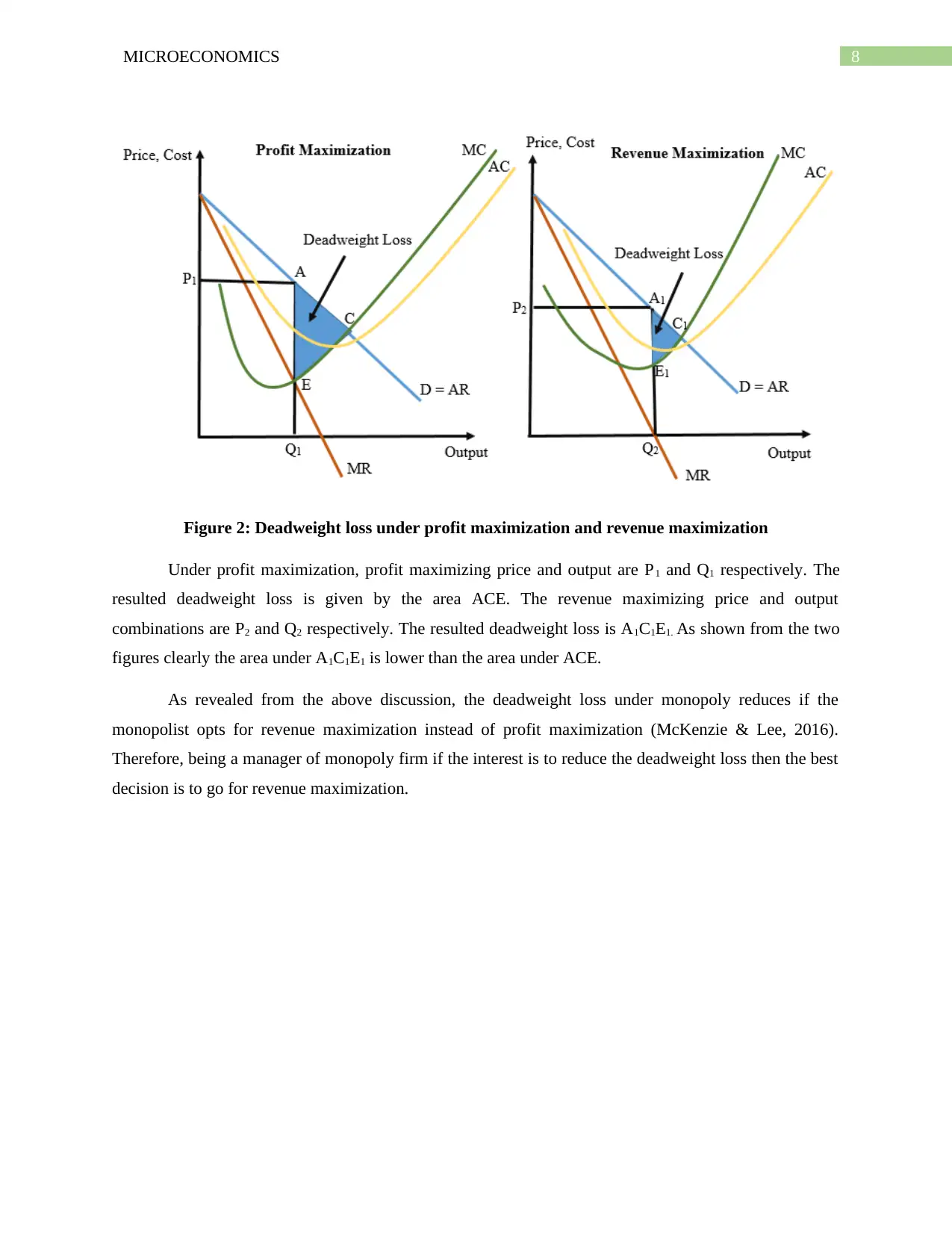
8MICROECONOMICS
Figure 2: Deadweight loss under profit maximization and revenue maximization
Under profit maximization, profit maximizing price and output are P1 and Q1 respectively. The
resulted deadweight loss is given by the area ACE. The revenue maximizing price and output
combinations are P2 and Q2 respectively. The resulted deadweight loss is A1C1E1. As shown from the two
figures clearly the area under A1C1E1 is lower than the area under ACE.
As revealed from the above discussion, the deadweight loss under monopoly reduces if the
monopolist opts for revenue maximization instead of profit maximization (McKenzie & Lee, 2016).
Therefore, being a manager of monopoly firm if the interest is to reduce the deadweight loss then the best
decision is to go for revenue maximization.
Figure 2: Deadweight loss under profit maximization and revenue maximization
Under profit maximization, profit maximizing price and output are P1 and Q1 respectively. The
resulted deadweight loss is given by the area ACE. The revenue maximizing price and output
combinations are P2 and Q2 respectively. The resulted deadweight loss is A1C1E1. As shown from the two
figures clearly the area under A1C1E1 is lower than the area under ACE.
As revealed from the above discussion, the deadweight loss under monopoly reduces if the
monopolist opts for revenue maximization instead of profit maximization (McKenzie & Lee, 2016).
Therefore, being a manager of monopoly firm if the interest is to reduce the deadweight loss then the best
decision is to go for revenue maximization.
⊘ This is a preview!⊘
Do you want full access?
Subscribe today to unlock all pages.

Trusted by 1+ million students worldwide
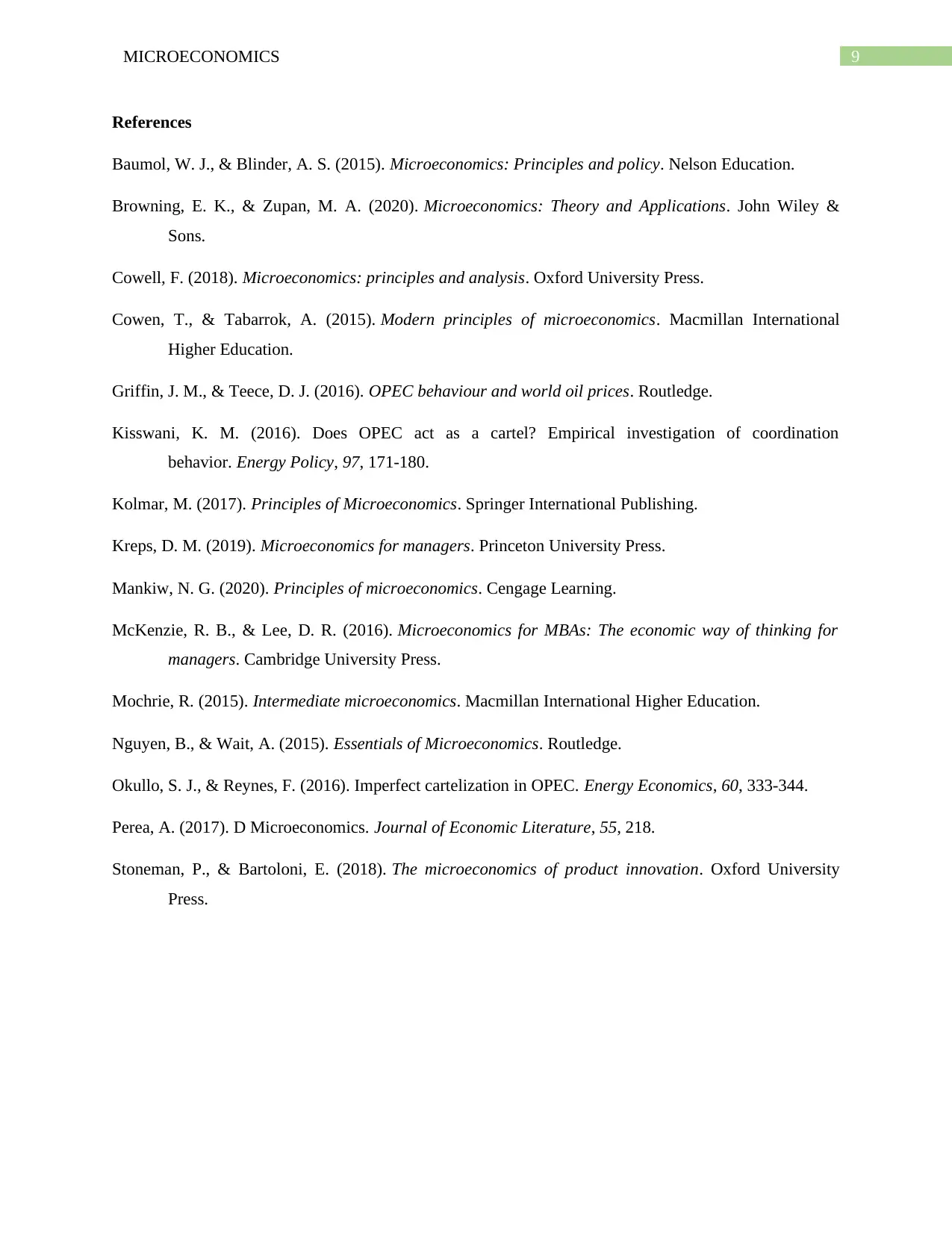
9MICROECONOMICS
References
Baumol, W. J., & Blinder, A. S. (2015). Microeconomics: Principles and policy. Nelson Education.
Browning, E. K., & Zupan, M. A. (2020). Microeconomics: Theory and Applications. John Wiley &
Sons.
Cowell, F. (2018). Microeconomics: principles and analysis. Oxford University Press.
Cowen, T., & Tabarrok, A. (2015). Modern principles of microeconomics. Macmillan International
Higher Education.
Griffin, J. M., & Teece, D. J. (2016). OPEC behaviour and world oil prices. Routledge.
Kisswani, K. M. (2016). Does OPEC act as a cartel? Empirical investigation of coordination
behavior. Energy Policy, 97, 171-180.
Kolmar, M. (2017). Principles of Microeconomics. Springer International Publishing.
Kreps, D. M. (2019). Microeconomics for managers. Princeton University Press.
Mankiw, N. G. (2020). Principles of microeconomics. Cengage Learning.
McKenzie, R. B., & Lee, D. R. (2016). Microeconomics for MBAs: The economic way of thinking for
managers. Cambridge University Press.
Mochrie, R. (2015). Intermediate microeconomics. Macmillan International Higher Education.
Nguyen, B., & Wait, A. (2015). Essentials of Microeconomics. Routledge.
Okullo, S. J., & Reynes, F. (2016). Imperfect cartelization in OPEC. Energy Economics, 60, 333-344.
Perea, A. (2017). D Microeconomics. Journal of Economic Literature, 55, 218.
Stoneman, P., & Bartoloni, E. (2018). The microeconomics of product innovation. Oxford University
Press.
References
Baumol, W. J., & Blinder, A. S. (2015). Microeconomics: Principles and policy. Nelson Education.
Browning, E. K., & Zupan, M. A. (2020). Microeconomics: Theory and Applications. John Wiley &
Sons.
Cowell, F. (2018). Microeconomics: principles and analysis. Oxford University Press.
Cowen, T., & Tabarrok, A. (2015). Modern principles of microeconomics. Macmillan International
Higher Education.
Griffin, J. M., & Teece, D. J. (2016). OPEC behaviour and world oil prices. Routledge.
Kisswani, K. M. (2016). Does OPEC act as a cartel? Empirical investigation of coordination
behavior. Energy Policy, 97, 171-180.
Kolmar, M. (2017). Principles of Microeconomics. Springer International Publishing.
Kreps, D. M. (2019). Microeconomics for managers. Princeton University Press.
Mankiw, N. G. (2020). Principles of microeconomics. Cengage Learning.
McKenzie, R. B., & Lee, D. R. (2016). Microeconomics for MBAs: The economic way of thinking for
managers. Cambridge University Press.
Mochrie, R. (2015). Intermediate microeconomics. Macmillan International Higher Education.
Nguyen, B., & Wait, A. (2015). Essentials of Microeconomics. Routledge.
Okullo, S. J., & Reynes, F. (2016). Imperfect cartelization in OPEC. Energy Economics, 60, 333-344.
Perea, A. (2017). D Microeconomics. Journal of Economic Literature, 55, 218.
Stoneman, P., & Bartoloni, E. (2018). The microeconomics of product innovation. Oxford University
Press.
1 out of 10
Related Documents
Your All-in-One AI-Powered Toolkit for Academic Success.
+13062052269
info@desklib.com
Available 24*7 on WhatsApp / Email
![[object Object]](/_next/static/media/star-bottom.7253800d.svg)
Unlock your academic potential
Copyright © 2020–2025 A2Z Services. All Rights Reserved. Developed and managed by ZUCOL.





